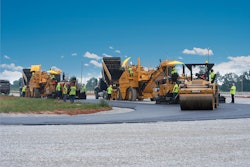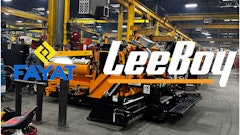
Cutting costs is an essential key to succeeding in business. Arguably, one of the most expensive recurring costs on your equipment is buying new tires, especially tires you’re putting on a sweeper.
“Sweepers are known to go through tires fairly quick,” says Jim Adair, director of product management at Schwarze Industries, Inc. “Especially due to the weight of the sweeper.”
In fact, tires for a sweeper, if purchasing a high quality tire, can cost anywhere from $150 - $250 per tire, for a 40,000 to 60,000 mile tire. But don’t expect to get that much mileage from them. Front tires will normally last for 8,000 – 15,000 miles, while the rears last a little longer, ranging 15,000 – 30,000 miles.
“Two factors contribute to the higher wear that you see on sweeper tires compared to normal vehicles,” says Jake Hoerman, sale and marketing at NiteHawk Sweepers. “The first is the higher weights of the sweepers, especially when carrying a full load of debris and the bigger primary factor in high wear, especially on the front tires, is due to the sweepers driving in circles all night long – ie sweeping parking lots.”
While you can’t prevent tire wear, sweeping manufacturers do agree that there are a few things you can do both at the point of purchase of new tires and throughout the life of the tires that may help to extend their usable life. From maintenance to operator behavior, here are some recommendations to help get the most from sweeper tires.
[The right tire for the job]
Just like you wouldn’t send a small skid-steer in to do a job meant for a full-size excavator, make sure when you do purchase new tires, they are properly matched for the equipment and the job. Looking at load range and tread type when making a tire purchase is important to ensuring you’ll get the most out of your tire investment.
“Sweeper tires need to be the right size and weight rating,” Adair says. “The weight ratings give you the benefit of what the tires can actually carry. The closer you get to filling the sweeper to that weight rating, the more the tire is going to deteriorate. You want to make sure you have a weight rating that is higher than what you’re going to be putting in the machines.”
“Tires should also be matched on the sweeper,” says Steven Dunning, technical training instructor at Elgin Sweeper Company. “Rear dual tires should be matched, the same size and type, and should be the same diameter across the whole axle. This will keep the sweeper level and assure all four rear tires are carrying the same load,”
Adair says purchasing tires that have a smaller tread pattern can also help as debris is less likely to get caught. “A big lug tire is going to pick up material into the tire,” he adds.
“Every operator is going to have their preference on what kind of tire to purchase based on opinion and regional preference" Adair says. "Some cities will only purchase the most expensive tires and others will go with a retread option, which will be less expensive and they’ll swear it wears the same.”
Hoerman, who was previously an operations manager for a sweeping company, says they tried both low cost tires and using retread tires on their sweepers. “We always had frequent problems with both,” he says.
Greg Kennel, owner of Best General Contracting in Shandon, OH, agrees. His company started in the sweeping business 15 years ago. After seven years of purchasing tires for his five sweeping units, he decided to start wholesaling tires himself. "The sweeping business led us to the tire business," says Kennel. "We were going through so many tires running those five trucks a night, we were buying them in bulk when we could find a good price. One thing led to another and we were led into buying our own tires directly.
"Sweeping is just a different animal than driving a vehicle on the road. Tires that tend to have a harder rubber compound are a little bit stiffer are good for a sweeping application," Kennel says. "Some of the cheaper grade tires actually work better for a sweeper truck, and I've found the cheaper tires do last just as long as the top tier tires, for sweeping at least.
"I mean, you can go through a parking lot at any time and run over a broken piece of glass and blow out that tire. Sometimes it's just not worth the cost on a sweeper to run a higher grade tire."
[Don’t skimp on regular maintenance]
Just like on your daily driver, vehicle maintenance can help your tires stay in better shape, and for longer. Improper tire inflation, plus a lack of rotation and vehicle alignment can all contribute to your tires wearing unevenly and prematurely.
Checking air pressure in the tires is one of the main things that can be done over the course of a sweep to help with tire performance. "If you run a tire pressure that's low, you're going to wear that tire out and fast," Kennel says. "The correct tire pressure will help more than anything."
Dunning agrees. “Sweeper tires will last longer when inflated properly to the specification on the side of the tire,” he says. “A fully inflated tire is very important to be able to support the load of the sweeper. Tires should be checked daily during the operator’s pre-trip inspection because of the environments sweepers are exposed to. The operator should never assume a tire that looks full is full. Check each tire with a gauge – and don’t just thump the tires. Low tires can be dangerous and will not support the load properly, creating heat, which damages the tires.”
“Rotation is also key as your front tires generally wear out before the rears,” Adair says. “You can get a little more life out of the tires if you purchase two new tires to put on the front and use the old ones in the back.”
Hoerman suggests rotating the tires front to rear every 5,000 miles.
“Alignment is critical as well,” Adair adds. “You can prematurely wear out a tire very quickly if your alignments are not correct. It’s important to keep up the balance on the tire too, especially if operating at highway speeds. As tires wear, the worse the alignment and balance will get. That will just decrease tire life even more.”
Hoerman says making sure you balance the tires and conduct an alignment on the vehicle at the time of tire purchase can also help to make sure you’re maximizing that tires life.
"By keeping up with all factory recommended maintenance for the vehicle (ball joints, bearings, struts, etc.), you can also help ensure the tires are not wearing prematurely due to improper or negligent repairs," Kennel says. "If you have a tire that's wearing funny, nine times out of ten it's because you have some part of your suspension that's bad."
[Driver diligence can help]
Finally, educating your drivers to be mindful of tire wear can also help.
“During sweeping, sweepers operate at very low speed, but gradually can reach high loads. It’s important to keep in mind that the tires are the “foundation” of the sweeper, so if the sweeper is leaning, it may not be sweeping evenly. That’s even more important when emptying the hopper. Changes to the center of gravity during sweeping and dumping can be accentuated by low tire pressure.”
If a driver is mindful of this, they may be encouraged to unload more frequently as a heavy truck wears down the tires faster.
“Having a diligent driver can definitely help,” Hoerman says. “If they avoid driving over pieces of metal and screws (if that can be avoided), that will help. Most blowouts I experienced (as an operator) were related to a scrap piece of metal stuck in the tire. On some level you simply accept this as the cost of doing business, but being aware can help.”
Finally, adjusting sweeping habits of a driver can help extend the life of a tire.
"Training your employees to drive a certain way is huge," Kennel says. "Tires are designed for pickup trucks and cars, not sweepers that make turns all night in parking lots. Every time you turn, you're just eating that tire up. If you can train your drivers not to make sharp turns and to drive a straight line sweep as much as possible through a parking lot, that can help a lot for the tires. It's tempting to zigzag and pick up a piece of trash on the other side of the lot, but the staighter you drive, the better off you're going to be."
“If a driver is making a lot of turns, that will obviously wear out the tires more,” Adair says. “As they are sweeping, if they keep in mind that tight turns wear tires more and are mindful of making wider turns or if they can make less turns by planning the route out, that can help extend tire life too. But a lot of that is just inherent with the job.”



![Lee Boy Facility 2025 17 Use[16]](https://img.forconstructionpros.com/mindful/acbm/workspaces/default/uploads/2025/09/leeboy-facility-2025-17-use16.AbONDzEzbV.jpg?auto=format%2Ccompress&fit=crop&h=100&q=70&w=100)







![Lee Boy Facility 2025 17 Use[16]](https://img.forconstructionpros.com/mindful/acbm/workspaces/default/uploads/2025/09/leeboy-facility-2025-17-use16.AbONDzEzbV.jpg?ar=16%3A9&auto=format%2Ccompress&fit=crop&h=135&q=70&w=240)








